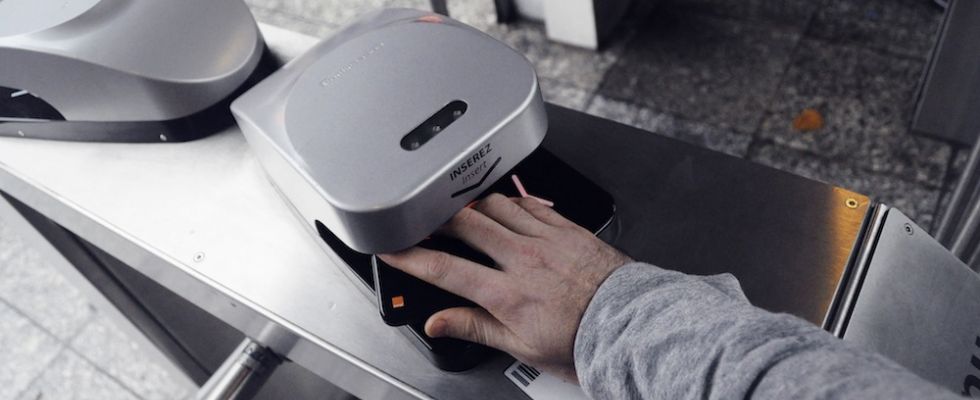The NFC Revolution
Smartphones have created an era of mass information thanks to the mobile internet. Now, with Field Communication (NFC) technology, mobile phones will let us do a whole lot more.

If you live in London, you probably own one of the five million Oyster cards swiped in and out of London Underground turnstiles and buses each day. This simple behaviour of touching an object against a reader to make a transaction is now being adopted by mobile phone consumers. Near Field Communication (NFC), a short-range wireless technology that lets people use a mobile phone to collect or share data with another device or NFC tag, will enable people to pay for products with their phone.
The reach is around 4cm, and is designed for tasks that require a close contact touch. The close proximity also means that data exchange is more secure, compared to alternatives such as Bluetooth. Another feature of NFC is that devices simply have to touch in order to establish a connection, and only one needs to be powered. This is similar to QR codes, as any inanimate object - a poster, product, wall of a shop or gallery - can hold and transmit information. But with NFC, there is also the option of peer-to-peer sharing because, unlike QR codes, NFC is dynamic and can hold information for temporary periods of time.
NFC isn’t a new innovation. In Japan, people have been using it for several years to pay for products in shops with NFC readers. Worldwide there are over 200 trials of various applications. But now NFC is growing rapidly as people are now familiar with the behaviour of swiping an object to pay for something. “Everybody understands the technology because of the Oyster card," says David Birch, director of transaction consultation firm Consult Hyperion and chairman of the Digital Money Forum.
"Early pilots showed no customer resistance. People like it."Smart posters can supply detailed product information to consumers as they wave their NFC-enabled phone over them. The technology’s primary use is to make contact-less payments. People can already use NFC to make payments for goods in shops.
In the UK, Barclaycard is using the technology in its most recent debit cards. Around 40,000 retailers are already able to facilitate wireless payments and its contactless debit card has over 10 million users in the UK.
The high street bank has also launched a contactless mobile payment service with http://www.orange.co.uk. The Quick Tap app lets people load up to £150 on to their phone and make payments of up to £15 in shops with NFC readers. For higher amounts or multiple payments, people are required to enter a pin code.
As more of these stores install NFC readers, money as hard cash, and even credit cards, may start to become obsolete. "Currently NFC is being used in the coffee shop mode with people paying for low value items as a quick alternative to cash," says Dave Snow, Senior Analyst at Juniper Research. "But as their confidence grows, NFC is expected to enable higher value transactions as an alternative to credit and debit cards." And it won’t be long until we’re all using it. According to Juniper Research, global contactless payment transactions on mobile phones will reach nearly $50 billion worldwide by 2014.
The growth in the market is also being helped by the increase in handsets that are NFC-ready. Google's Nexus S phone has the technology already built in. Blackberry has put NFC in all its new models this year. And by 2014, around one-fifth of all smartphone devices in the world will have NFC capability, according to Juniper Research.As well as payments, NFC can be used as a method of communication between a phone and another object. This is called ‘pairing’. People can use their NFC mobile obtain information by swiping it on a NFC tag, which can be placed on just about anything. In other words, any object can have information embedded into it.
Brands are already using pairing to make their billboard advertisements interactive. Earlier this year in London, billboards for the X-Men First Class film in May featured embedded NFC tags. People could tap them with their phone, and be taken to a mobile website with exclusive content. "These smart posters can supply detailed product information to consumers as they wave their NFC-enabled phone over them," says Snow. "These posters could also be used to download coupons to the phone which are redeemed during the payment process at the retailer."
Video game developer Rovio has added location-based services to the technology. As part of the advertising for its Angry Birds game Magic Places, it created a campaign that lets players tap their phone on NFC readers found in real-world locations such as shops in order to gain access to new characters and levels within the game.
NFC also lets people share information with each other. It could enable people to use their phone to share business card information or play multi-player games with each other. Consult Hyperion’s Birch predicts people will use their phone to send the relevant social profile in real life social situations. "People will be able to choose from a menu on their phone whether they want to send their Linkedin or their Facebook," says Birch. "You’ll use your phone to choose who you want to be."
People could even embed these social profiles into other objects, predicts Birch. "You could put your Facebook URL into an NFC tag and put it into a notebook that people could scan with their phone to load your profile," says Birch. "It’s a step towards the internet of things."
What’s next?
The potential uses for Near Field Communication technology for a variety of industries is huge. It could help workers that hot desk in an office by turning any desktop or laptop they sit at into their own. By tagging and laying their phone next to an NFC screen, a person's files could be uploaded from the cloud, and when they remove their phone, all their information would leave with them.
In hospitals, patients could use their NFC phones to swipe-in and out of medical facilities, and instantly scan and download information on prescribed medication. In restaurants, menus could have NFC tags embedded that translate the descriptions of meals into foreign languages. It could even be used to let people start their car, just be placing their phone next to the ignition.
NFC technology will be the next step in the mobile revolution. Just don’t lose your phone. Or drop it in your drink.


